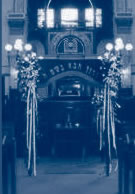|
SEDRA : Korach Hertz Chumash p. 639 Numbers
Chap. 16
This week's Sedra is generously sponsored by Danny Jedwab.
SYNOPSIS:
The Sedra commences by describing the great rebellion against
Moses and Aaron. A group of Levites under the leadership of
Korach and a group from the tribe of Reuben under Datan, Aviram
and On ben Pelet together with 250 prominent members of the
community participated in the revolt. Korach contended that
he should have been appointed the Prince of the tribe of Levi.
Datan and Aviram claimed their rights to leadership based
on their descent from Reuben, Jacob's eldest son.
Responding to their challenge, Moses calls upon the rebels
to appear the next day to meet him. He warns the people to
stay clear of Korach and his assembly and announces the sign
which will indicate whom G-d has chosen as their legitimate
leader. If the rebels die a natural death, Moses would be
rejected, but if they are swallowed alive by the earth, this
would vindicate Moses as the true leader.
No sooner had Moses spoken than Korach, his followers and
their possessions were swallowed alive into the ground. The
remainder of the people dispersed in terror.
The people then began to murmur and held Moses responsible
for the death `of the people of G-d'. A plague spread quickly
among the people taking the lives of a great number of the
murmurers. When Aaron moved among the people with a pan of
incense, the plague subsided.
G-d then ordered the prince of each tribe to present his
staff at the Tent of Meeting. The staves, together with the
staff of Levi bearing the name of Aaron, were placed in the
Ark. On the morrow Aaron's rod was found to have miraculously
produced buds, blossoms and almonds. This indisputable sign
vindicated Aaron as G-d's chosen Kohen Gadol. The rod of Aaron
was to be kept in the Ark to indicate that the rights of the
Kohanim are to be preserved and never to be challenged.
The Priests and Levites were not allocated a specific portion
in the land of Israel, their work was the Service in the Temple.
It was the obligation of the nation to support them through
a system of contributions. The Kohanim received first fruits,
the redemption of the first born, the Terumah (a portion of
each persons produce the size of which was discretionary)
and various offerings. The Levites would receive the First
tithe out of which each Levite would have to set aside Terumah
for the Kohen.
HAPHTORAH HERTZ CHUMASH P. 944 Isaiah Chapter 66
The final chapter of Isaiah comprises the reading when Shabbat
and Rosh Chodesh coincide owing to its reference in the penultimate
verse to the continued and ever more popular observance of
Rosh Chodesh in the future. The chapter combines fierce admonition
for those who pervert sincere observance, mock the ways of
G-d and worship idolatry while it also describes the rebirth
of Israel and the ingathering of exiles.
The penultimate verse referring to Rosh Chodesh is repeated
again after the conclusion of the Haphtorah.
TELL ME RABBI ......
"BLESSED ART THOU .... WHO CROWNS ISRAEL WITH GLORY"
(Sidur page 7) HOW TO PUT ON TEPHILLIN
I. Stand quietly, take the Hand Tephillah (Shel Yad), remove
the cap and unwind the straps (Retzuot)
Place the hand Tephillah on the left arm (if left handed,
the right arm)
Set the hand Tephillah on the arm with the broad side of the
'lip' or edge toward the top oft the arm.
Check that the knot is adjacent to the box and tighten the
strap
Recite the Blessing: Baruch ata......Asher kid'shanu b'mitzvotav
v'tzivanu l'haniach Tephillin [Sidur p.2;6]
Wind the strap around the bicep, then wind it seven times
around the forearm below the elbow to the wrist with a counter-clockwise
(Ashkenazic practice) motion. Wrap the remaining length of
strap the hand (temporarily).
II. Take the Head Tephillah (Shel Rosh), remove the cap and
place the Tephillin on the head.
Tephillin (hand and head) must come in direct contact with
the body without any intervening materials.
Say the Blessing: Baruch ata......asher kid'shanu b'mitzvotav
v'tzivanu al Mitzvat Tephillin Baruch Shem K'vod Malchuto
l'olam vaed [Sidur p.3;6]
Adjust the Tephillin to rest comfortably and correctly on
the head, placed above the hairline centred between the eyes.
The knot of the head strap should be centred behind the head
in the indentation at the base of the skull. The straps are
brought forward to hang loosely down the front of the body
(shiny black side up).
III. Unwrap the strap from the palm and wind it twice around
the bottom part of the middle finger (closest to the knuckle)
and once around the middle part of the same finger. The rest
of the strap is brought back around the fourth or 'ring' finger
and then rewound to its end around the palm.
While doing this recite the following:
V'erastich li l'olam
V'erastich li b'tzedek uv'mishpat uv'chesed uv'rachamim
V'erastich li be'emuna v'yada'at et Hashem [Sidur p.3;6]
Removing the Tephillin
Unwind the strap around the fingers.
Remove the strap around the head and roll it up neatly.
Unwind the strap from the palm and arm .
Slip off the hand Tephillah and roll it up neatly. How the
Tephillin are wrapped is not significant.
Tephillin must certainly not be worn in the bathroom.
BACK TO SHABBAT SHALOM
TABLE
|








